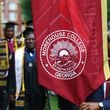When Carly Armstrong decided to attend The University of Mississippi after graduating from Harrison High, her mother sat her down for a talk about James Meredith.
“‘Listen to this history, Carly,’” Armstrong recounted of the day her mom — former Marietta Daily Journal columnist Laura Armstrong — explained how Meredith braved armed opposition in 1962 to become the school’s first African-American student.
“Everybody knows who James Meredith is,” said Armstrong, among the growing number of Georgians choosing Ole Miss. “You know about him the minute you decide to go to school there.”
Like many across the region and beyond, Armstrong was stunned when Meredith’s statue was found last week with a noose and Georgia’s former state flag draped around its neck. The event, which occurred not so subtly during Black History Month, immediately brought back memories of uglier times on the Oxford campus and in the South itself.
Learning that three white freshman from Georgia are now the subject of a FBI investigation into the Feb. 16 incident hits Armstrong and many across the state in deeply personal ways.
“They’re an embarrassment to our university and community of Oxford, and they’re an embarrassment to Georgia,” said Armstrong, who is white and who graduated last year.
Victor Macias, a 22-year-old marketing major from Cumming, feels much the same.
“They are representing our home state and they made us look really bad,” said Macias, who is Hispanic. “Since Georgia is one of the top states that bring students to Ole Miss, it’s just sad that we are all being represented by them.”
For many, the incident isn’t just a black eye to the university, which despite efforts like changing its on-field mascot from the “Rebels” to a black bear, maintains the hallmarks of its past with monuments and roadways bearing Confederate ties.
The statue’s desecration — and the involvement of three Georgians — digs up painful reminders of the Peach State’s own deep-seated battle with racial inequality.
Federal and school authorities have not yet made public the students’ identities, and no arrests have been made. The Atlanta Journal-Constitution is withholding names pending confirmation. Calls to their families were not returned Sunday, though one parent declined comment before hanging up on a reporter.
The Rev. C.T. Vivian, a recipient of the Presidential Medal of Freedom for his work in the Civil Rights Movement, said the problem isn’t isolated to Ole Miss.
The Atlantan worries what it means for future generations of Southerners.
“We’re still dealing with the Old South,” he said. “Later as adults, what will they really be like in terms of our hopes and dreams and the things we have fought and struggled for?”
Cherokee County native Mel Lasseter, who graduated Ole Miss last year with a master’s degree in Southern studies, said it was more than the men’s backgrounds that caught her attention. It was the flag they’re accused of draping across the statue — a former Georgia model bearing the Confederate battle emblem.
“Why the old flag, and not the Mississippi state flag?” said Lasseter, who is now seeking a doctorate in American studies from the University of North Carolina.
Georgians voted to change the state flag under former Gov. Sonny Perdue in 2004, when the accused were merely children. Lasseter, who is white, said seeing a Confederate battle flag isn’t altogether unusual, but wondered why the men had Georgia’s former flag in tow.
“What kind of statement were they trying to make about Georgia?” she said.
Frank Catroppa, former head of the Martin Luther King Jr. National Historic Site, said the students should be expelled from the school if the allegations are true. He described the incident as “disheartening.”
“I think somebody who would do something like that to a symbol of the civil rights struggle … needs an awakening,” he said. “Maybe sending them home will open their eyes.”
The university has not yet taken action against the men pending an investigation, but they were expelled from the Sigma Phi Epsilon fraternity last week. The chapter was suspended by the national organization.
Jeremy Smith, president of the Ole Miss chapter, said the group voted to oust the men Wednesday following the incident, which he described as a “humbling experience.”
“It has forced us to reconsider the process we use to evaluate new members and the assumption that this kind of behavior couldn’t occur in 2014,” Smith wrote in an emailed interview. “The act of desecrating a statue of a civil rights leader like James Meredith represents a culture that should be long gone and one that has absolutely no place in our fraternity.”
Quadray Kohlheim, the president of the university’s Black Student Union, worries the very structure of the Greek system breeds this kind of problem.
“The organizational culture of Greek life, in general, fosters this homogeneous mindset that for some reason leads some of its members to feel comfortable behaving in racist and other discriminating ways,” he said in an email.
Kohlheim, originally from Tupelo, Miss., said he was pleased the college’s Interfraternity Council — which oversees the majority white fraternities — issued a statement condemning the act.
Still, damage has been done.
“This incident intimidated and hurt many individuals at our institution,” he wrote. “The actions are a step back in the progress that has taken place over the past 51 years.”
Increasingly selective enrollment at the University of Georgia has more students considering Ole Miss among other big schools. About 850 of the university’s 16,500 students were from Georgia in 2011, an increase of 30 percent from 2007 levels, according to the latest statistics. Only Texas and Tennessee send more out-of-state students to the university.





